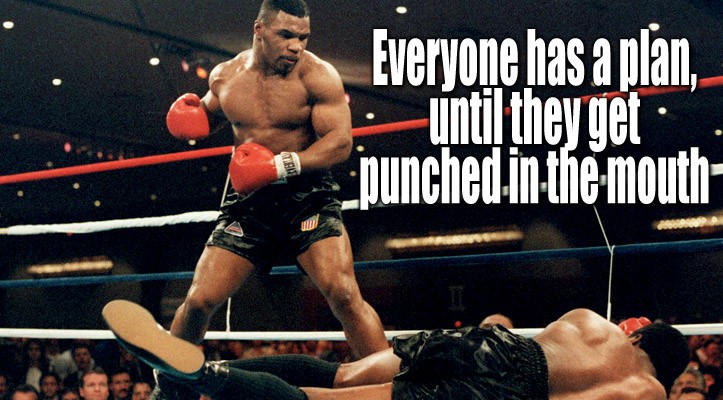When Mike Tyson was asked by a reporter whether he was worried about Evander Holyfield and his fight plan he answered; “Everyone has a plan until they get punched in the mouth.”
This quote isn’t an argument against planning, but reminds us planning is a continuous and flexible process. The real value of proper planning comes from the ability to adapt and be resilient when reality deviates from the plan. In mining, this deviation is a guarantee. The key to successful planning is in the ability to create and adapt plans to account for these changes and still meet long term goals.
What Tyson said is similar to the old saying “no plan survives first contact with the enemy”. But does this mean that there is no need to plan? Absolutely not. Holyfield was no doubt smarter and more strategic than Tyson (hard not to be), but was Tyson right? Tyson was a brawler, awesome at powerfully fighting his way out of a corner and landing devastating blows. Could Holyfield have planned to have half of his ear bitten off? How did he respond to Tyson’s unpredictable nature?
How do you adapt your plan when you get punched in the mouth?
Holyfield won. Despite the massive 15/2 odds against him. However, had he blindly followed his plan when things had changed he may not have. The question is how you adapt your plan when you get punched in the mouth. There are two key things here:
- Most of the plan should survive despite everyone being focused on the bit that is broken. So, keep the old plan in mind when working out the new plan. You may have a puffed up eye and half an ear but your arms and legs are still working. Don’t stop moving, defending and throwing punches.
- The new plan needs to deal with right now reality. There’s no point thinking about training and strategy while you’re being punched in the face. Your ear hurts and your eyes are swelling so you need to think and make a decisive decision. In this case the fighter can either to go for a knockout now or stay away for a while. His choice will have knock on effects for the rest of the fight but the fighter needs to make a decision or get punched in the face again.
Applying Mike Tyson’s ideas to operational mine planning and execution
To bring this back to the workplace (and mining): if you’ve created a detailed work plan for your team that fully utilizes your people and equipment and key people call in sick or a machine breaks down. What do you do?
- Most of the plan should survive, priority jobs should still happen and most of the team should be able to carry on doing what they were planned to be doing. So, adapt the current plan to cope with the change, don’t throw it all out and start again.
- The new plan needs to deal with right now reality. In most cases planners won’t be around to help so your supervisor needs to be able to solve the problem himself, this means they must both understand the plan (the why behind the what) and believe that they have the authority to change it. Someone didn’t come in, I can borrow someone or do a different job from tomorrow’s plan. Machine is broken, can I do contingency work, fix it or borrow another machine. The last thing you want is for people to stand around doing nothing.
Both Tyson and Holyfield were right, plans shouldn’t survive the first punch in the mouth but you need one in the first place to be able to adapt it for changes in reality… “Victorious warriors win first and then go to war, while defeated warriors go to war first then seek to win” Sun Tzu, the Art of War. Static execution plans in mining will be affected by equipment breakdowns, adverse weather, changes in ground conditions, staff availability/roster issues, enabling activities or dependent tasks. Methodologies like the ‘Plan, Do, Check, Act’ cycle, Short Interval Control and Last Planner Systems can drive operational and planning excellence!
So, be like Holyfield, put a plan together in sufficient detail to “win first” but ensure you can adapt this plan so that one “punch in the mouth” does not result in defeat. Holyfield won with a TKO in the 11th round after Tyson tried to bite his other ear. Some things you just can’t plan for!
Can technology like CiteOps help you adjust and adapt your operational plans?
CiteOps combines a set of tools, processes and behaviours that connect strategic planning activities with front-line operational execution. This software provides visibility, coordination, and feedback. It enables effective planning behaviours so that work can be executed on each shift. It promotes effective leadership behaviours throughout the shift to help achieve targets.
- One Plan visible to everyone on site, with real time data to improve the co-ordination of work site wide.
- Ability to track activities in near real time and respond to variance.
- A platform that links the Weekly Schedule with the Shift Plan, Short Interval Control and the Shift Report.
- Improve resource efficiency, productivity and production results.
- Good planning leads to safer execution.
- Ensure that the right people, do the right work, at the right time – greater compliance to plan.





